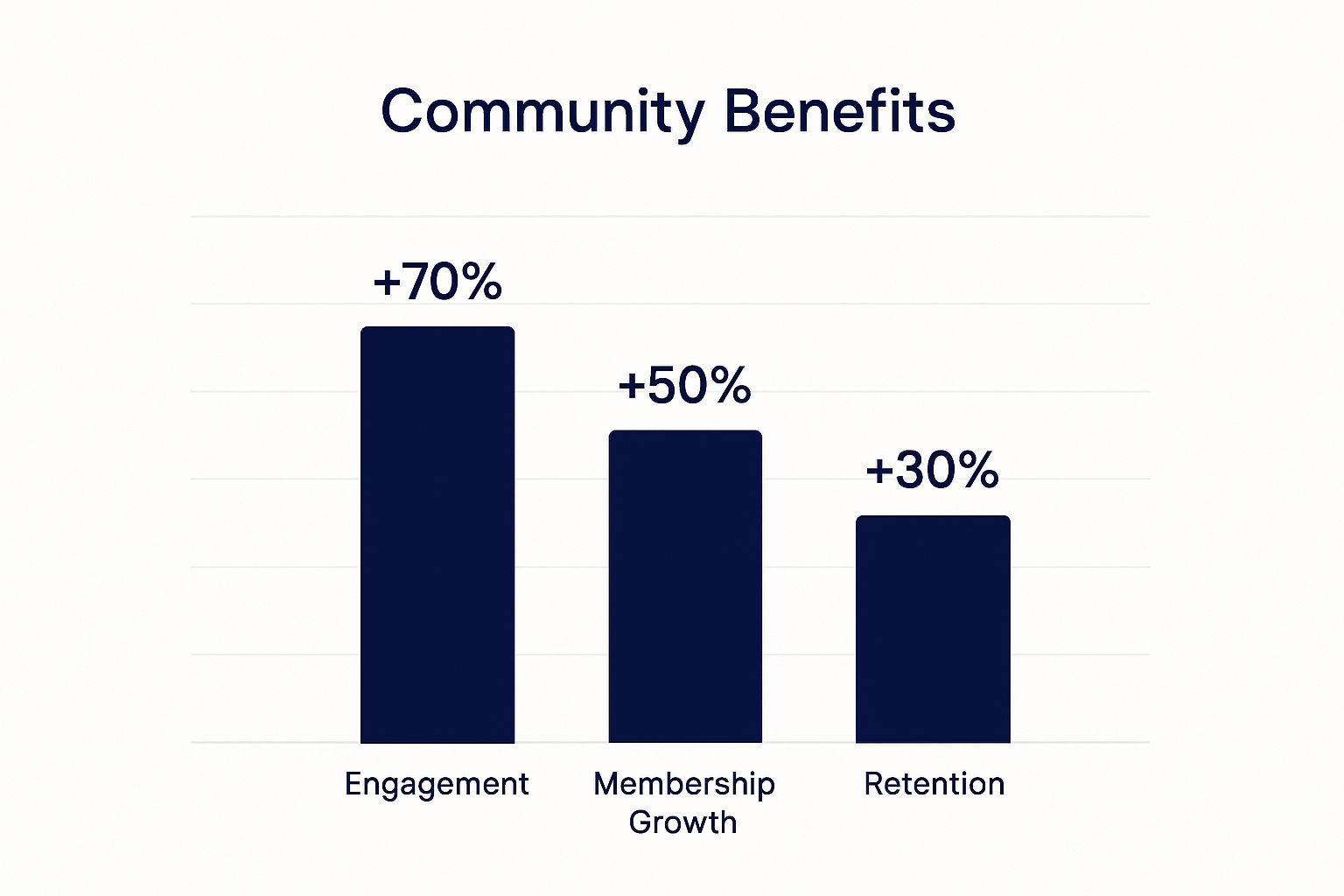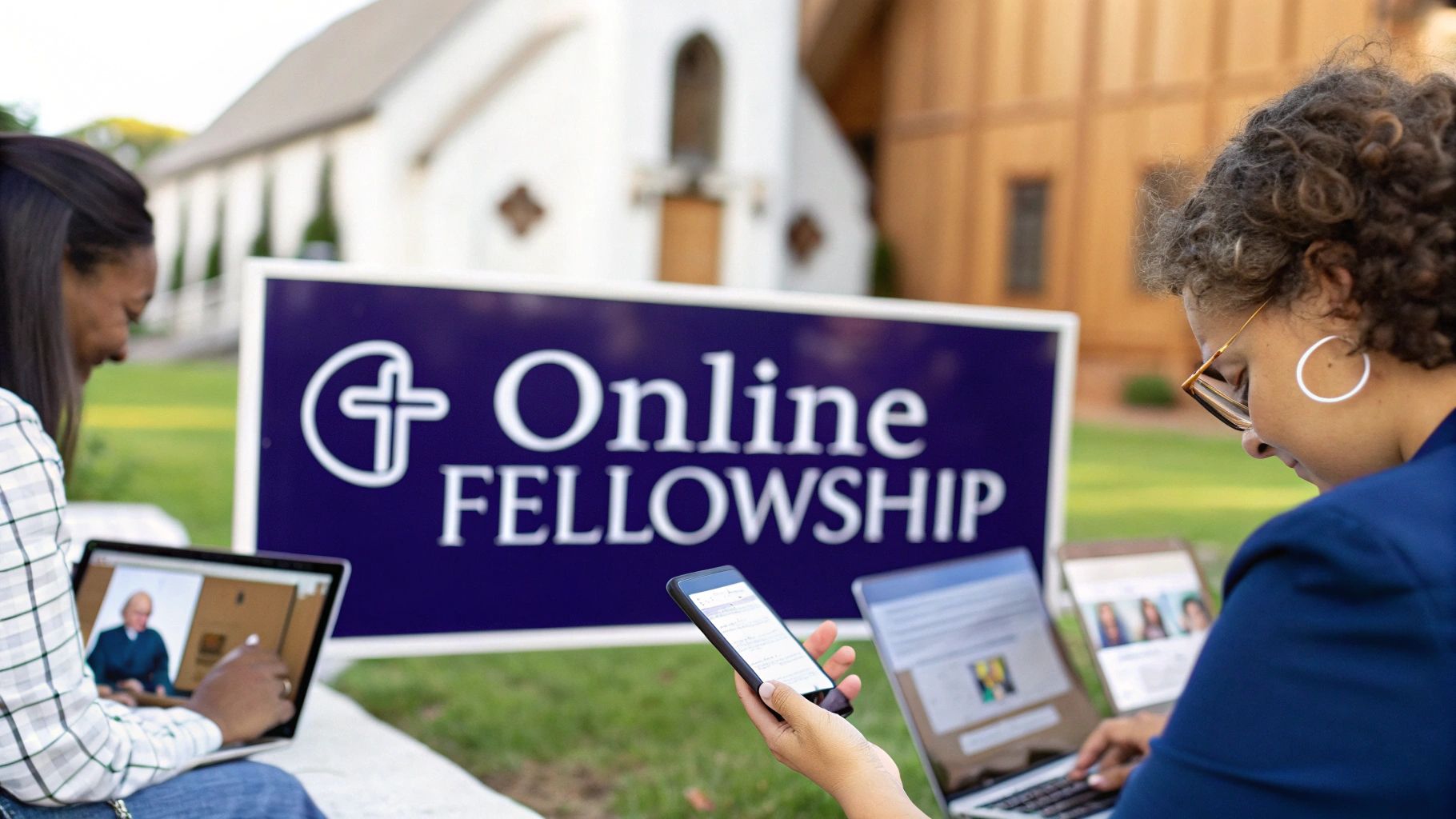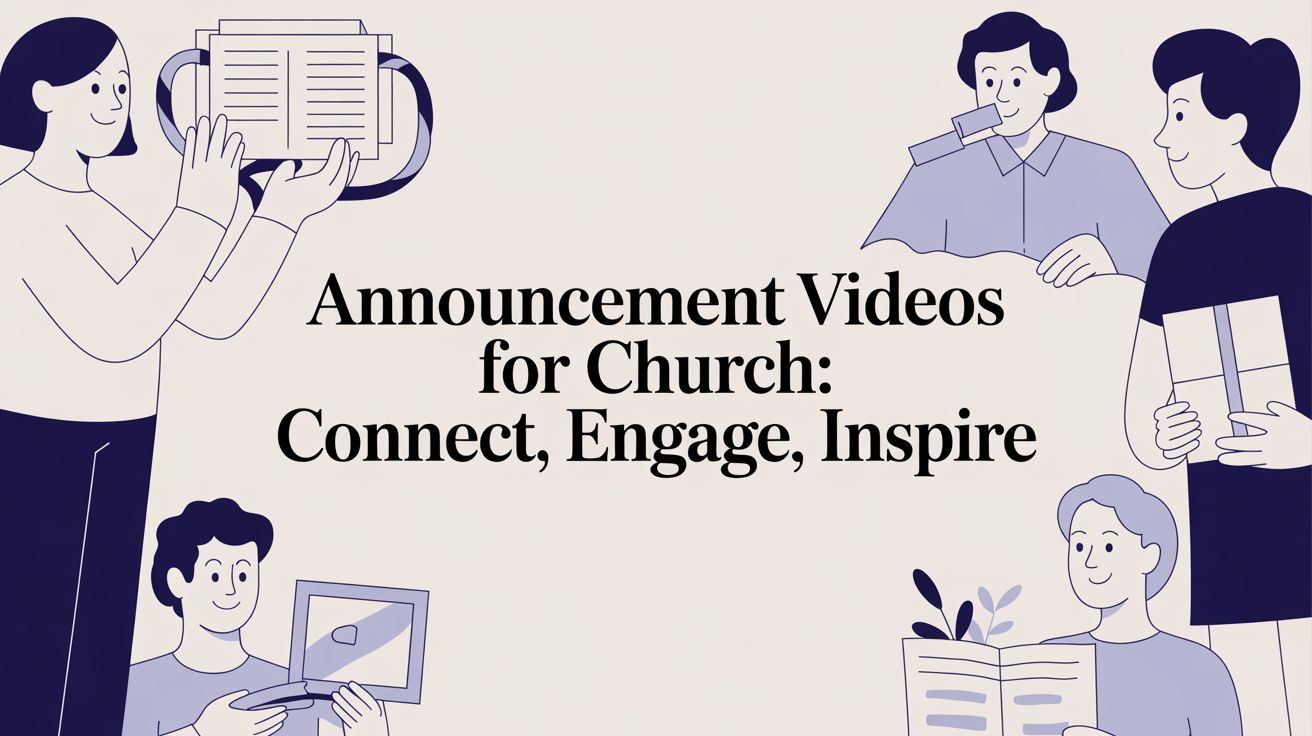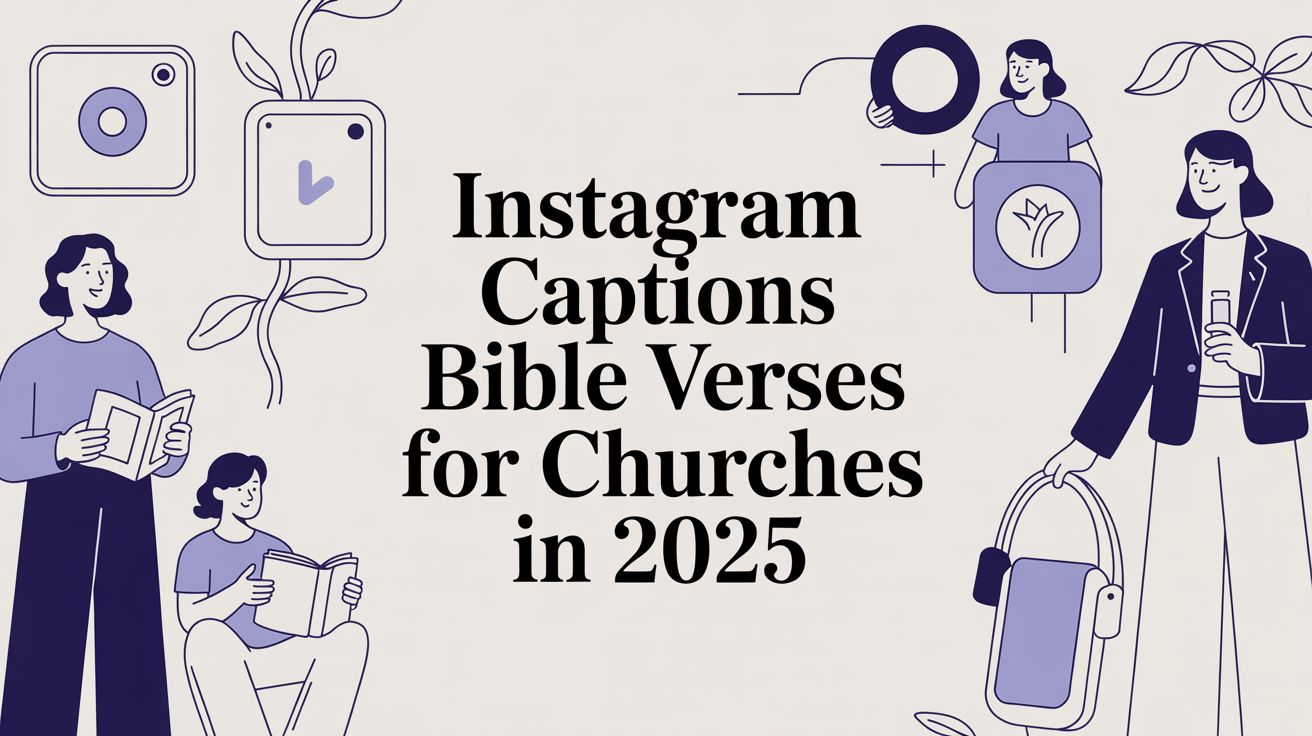An online community isn't just a broadcast channel—it's about creating a living, breathing fellowship that thrives all week long. It’s a shift from just streaming a service to actually fostering the relationships and support that happen in the hallways after the service. Think of it as the digital version of your church's coffee hour, always open and ready for connection.
This is about meeting your congregation right where they are, every single day, and nurturing your flock far beyond Sunday morning.
Why Your Church Needs a Digital Community Now
In a world where so much of our life happens online, your ministry has a powerful opportunity to connect with people well beyond the four walls of your church building. An online community is no longer a "nice-to-have" add-on; it's a core part of what it means to be a connected, modern church. It's your 24/7 fellowship hall.
This goes way beyond simply putting your Sunday service on the internet. We're talking about turning a one-way monologue into a dynamic, two-way conversation that keeps your congregation connected and encouraged throughout their week. It's the difference between a lecture and a vibrant small group discussion where everyone feels seen, heard, and valued.
Before we dive into the "how," let's look at the fundamental shift this represents.
The Shift from Traditional Outreach to Digital Community
This table breaks down the difference between the weekly touchpoints of the past and the daily connection that a digital community makes possible.
As you can see, the goal is to deepen the relationship from a once-a-week event to a daily journey of faith, together.
The Unprecedented Opportunity in Social Media
The sheer scale of this opportunity is hard to overstate. By 2025, there will be around 5.45 billion people using social media globally. That's up from 4.72 billion in 2023. People are spending, on average, 2 hours and 24 minutes a day on these platforms. This isn't just noise; it's a massive window for your church to connect with your congregation in a truly meaningful way.
By building a community where people already spend their time—like on Facebook or Instagram—you can:
- Foster Deeper Relationships: Create genuine spaces for people to share prayer requests, celebrate testimonies, and discuss life's big questions. This is where real bonds form.
- Provide Consistent Spiritual Nourishment: Keep the Sunday message alive all week with sermon highlights, thought-provoking questions, and bite-sized words of encouragement.
- Reach Those Unable to Attend Physically: You become a lifeline for the homebound, the sick, or those with packed schedules, making sure they never feel disconnected from their church family.
The infographic below really drives home the benefits churches are seeing when they pour into their digital communities.

The numbers don't lie. A well-run online presence leads directly to higher engagement, real membership growth, and better retention. If you're looking for more foundational strategies on making digital groups work, this is a comprehensive guide to building an online community.
Making It Manageable for Your Ministry
Okay, let's be real. The thought of managing multiple social media accounts can feel like a full-time job, especially if you're working with a small staff or a handful of volunteers. This is exactly why a tool like ChurchSocial.ai is such a game-changer. It’s built to do the heavy lifting for you.
Imagine this: you preach a sermon on Sunday, and with just a few clicks, that one message becomes a full week of engaging content. ChurchSocial.ai can generate reels from your sermon, create social posts and blogs from the transcript, and provide graphic templates to bring it all to life. It's not about adding more to your plate; it's about making your work go further.
With simple graphic templates, a drag-and-drop calendar, and smart integrations with tools you already use like Planning Center, ChurchSocial.ai makes the whole process feel effortless. It gives you the power to build an incredible online fellowship without needing a huge communications team or a massive budget.
Turn Your Sermon into a Week of Content
Let’s be honest: your weekly sermon is the single most powerful piece of content your church creates. But what happens after the "Amen"? Too often, that message fades by Monday morning.
Imagine, instead, if you could take that Sunday sermon and let it fuel your online community all week long. This is how you shift from a once-a-week event to a daily journey of faith with your congregation. It's not about creating more work for your team; it's about being smarter with the powerful message you already have.
That Sunday sermon becomes the heartbeat of your digital ministry, pumping life into your social media channels from Monday through Saturday. This is exactly where a tool like ChurchSocial.ai steps in, doing the heavy lifting to turn one powerful message into a whole stream of engaging content.

From Sermon Transcript to Social Gold
It all starts with your sermon transcript. When you feed this text into ChurchSocial.ai, you’re giving its AI the raw material to analyze the core themes, powerful statements, and key takeaways from your message. It’s not just pulling random sentences; it’s designed to understand the sermon's spiritual DNA.
For this to work well, a clean and accurate transcript is vital. If you need help streamlining this first step, looking into a reliable sermon transcription service can be a game-changer.
Once the AI has the text, it gets to work, generating a variety of assets perfectly suited for different platforms. This gives you a consistent flow of high-quality, relevant content that sparks real interaction.
Here’s what that looks like in practice:
- AI-Generated Reels: The system spots the most impactful 30-60 second segments—a compelling story, a key theological point, or an inspiring call to action—and turns them into short, shareable videos for Instagram and TikTok.
- Thought-Provoking Social Posts: It pulls out the sermon's main themes and crafts open-ended discussion questions or inspiring social media posts, perfect for getting conversations started in your Facebook group.
- Shareable Quote Graphics: The AI pinpoints the most memorable lines. From there, you can jump into ChurchSocial.ai’s graphic templates and editor to quickly create beautiful, branded images and carousels for your Instagram feed.
- Blogs and Articles: It can even help you expand on a single point from the sermon, turning it into a longer blog post to dive deeper into the topic for your church website.
This approach multiplies your impact without multiplying your effort. A single 30-minute sermon can effortlessly become 10-15 unique pieces of content, keeping the Sunday message alive and top-of-mind all week.
A Practical Workflow for Your Church
Picture your Monday morning. Instead of staring at a blank content calendar, you just upload your sermon transcript to ChurchSocial.ai. Within minutes, you have a library of fresh, relevant content suggestions ready to review and schedule.
Your week might look something like this:
- Monday: Pop into the platform and review the AI-generated content. Pick out the best video clip for a Reel, a few powerful quotes for graphics, and a couple of discussion questions.
- Tuesday: Drag and drop the Reel into the calendar to schedule it for Instagram, and set the discussion prompt to post in your Facebook group.
- Wednesday: Use the built-in graphics editor to polish a quote graphic and schedule it for your main feed.
- Thursday: Schedule a simple carousel post that breaks down one of the sermon's key points into three easy-to-digest slides.
- Friday: Post a "get ready for Sunday" message, maybe teasing the next sermon in the series and reminding everyone about service times.
This isn't just about filling a calendar; it's a genuine strategy for discipleship. By consistently reinforcing the sermon's message, you help your congregation see how its truths apply to their daily lives. You’re no longer just preaching on Sunday—you’re pastoring your community every single day, right where they are online.
Create Compelling Visuals and Plan Your Calendar
So, you’ve got a great well of content ideas flowing from your sermons. That’s a huge win. The next step is all about presentation—how you package those ideas to actually stop someone from scrolling.
In the world of social media, your visuals are your handshake. A professional, consistent look builds trust and makes your church instantly recognizable. This isn’t about needing a design degree; it’s about creating a cohesive visual feel that’s both intentional and welcoming. High-quality visuals are non-negotiable for everything from promoting your next sermon series to sharing an encouraging verse.
Design Professional Graphics in Minutes
Let's be real: creating eye-catching graphics is often the biggest bottleneck for churches. This is where the right tool can completely change the game. Instead of staring at a blank canvas and feeling overwhelmed, you can lean on pre-designed templates built for social media.
With ChurchSocial.ai, you get access to a whole library of graphic templates and a simple editor. It empowers anyone on your team—volunteer or staff—to create beautiful photos and carousels without any design experience.
- Sermon Series Packages: Get a unified look for your entire sermon series with matching graphics for Instagram posts, stories, and Facebook banners.
- Event Promotions: Quickly design sharp-looking announcements for youth group, worship nights, or that upcoming outreach project.
- Inspirational Posts: Turn a powerful quote from Sunday’s message into a shareable image that connects with people all week long.
This approach takes the guesswork out of design. It ensures every post looks like it belongs to your church, no matter who created it. That kind of consistency is what helps you stand out and become a familiar presence in a busy feed.
Master Your Content with a Simple Calendar
Creating great content is only half the job. Knowing when and where to post it is what actually drives engagement. A content calendar is the central nervous system for your online strategy, turning random posts into a purposeful plan.
It lets you see your whole month at a glance, helping you build a healthy mix of content—sermon clips, event promos, discussion questions, maybe even a member spotlight. A solid calendar prevents that last-minute panic and keeps your online presence active and reliable.
Planning ahead isn't just about being organized—it’s about being intentional. A calendar helps you strategically build momentum for events, deepen the impact of a sermon series, and ensure you're talking with your community, not just at them.
The thought of managing multiple platforms is enough to make anyone’s head spin. This is where a simple, visual, drag-and-drop calendar is a lifesaver. ChurchSocial.ai brings all your accounts into one planner.
You can schedule a post for Facebook, an AI-generated reel for Instagram, and a graphic for your Stories, all from the same screen. This saves an incredible amount of time and eliminates the stress of bouncing between different apps. If you need a solid framework to get started, using a proven social media calendar template can be a huge help.
Integrate and Automate Your Workflow
The real magic happens when your online efforts connect seamlessly with the actual life of your church. Your social media shouldn't feel like a separate, isolated task.
Imagine your upcoming small group from Planning Center automatically popping up on your content calendar as a potential post. ChurchSocial.ai makes this possible with direct integrations with Planning Center and other church calendars. This ensures your social media is always in sync with what’s really happening in your ministry. It turns real-life events into natural opportunities for online connection, reduces manual data entry, and frees up your team to do what matters most: engage with people.
Spark Genuine Engagement and Participation
So you’ve got a platform and you're creating content. That’s a fantastic start, but the real magic of an online community happens when people start talking to each other. A follower count is just a number; active, genuine participation is where real fellowship is built. This is where you get to turn passive scrollers into an engaged part of your digital church family.
The goal is to shift from one-way announcements to a space buzzing with real conversation. It means you have to be intentional about starting discussions, creating opportunities for people to share, and making it a safe place for everyone to chime in. Think of it as the digital version of catching up with someone in the church lobby after service.

From Sermon Content to Engaging Conversations
The content you’re already getting from your Sunday message is the perfect fuel for these interactions. Don’t just post a clip and call it a day—use it as a springboard for discussion. That powerful sermon reel or thought-provoking quote graphic you made with ChurchSocial.ai isn't just a piece of content; it's a conversation starter waiting to happen.
Here’s how you can put this into action right away:
- Ask Open-Ended Questions: When you post a sermon clip, follow it up with a question. Try something like, "What was one thing that stood out to you from this part of the message?" or "How can we apply this truth in our lives this week?"
- Run Relevant Polls: Jump on Instagram Stories or Facebook and use the poll feature. You can ask about potential outreach projects, sermon series topics, or even something as simple as what worship song has been on repeat for them lately.
- Create a Space for Sharing: A simple graphic that says, "How can we be praying for you this week?" can be incredibly powerful. It carves out a dedicated, safe space for members to share requests and rally around one another in the comments.
For this to really take root, it helps to lean on some proven community engagement best practices. These principles will help you build and maintain momentum so the conversations keep flowing naturally.
Leaning into Platform-Specific Features
Every social media platform has its own set of tools designed for connection. Using them shows you understand the digital space your people are in and that you want to meet them there. Don't hesitate to experiment with these features to see what really connects with your church family.
Try working these into your weekly rhythm:
- Instagram & Facebook Stories: Use the "question" sticker for a quick "Pastor Q&A" session tied to the recent sermon. It’s informal and highly interactive.
- Facebook Live: Hop on for a 10-15 minute live video mid-week. It could be a short devotional or just a casual check-in. This unpolished, real-time format builds a strong sense of personal connection.
- Create Themed Days: Why not start a "Testimony Tuesday" or "Thankful Thursday"? Encourage members to share short stories of what God is doing in their lives.
The key here is consistency and responsiveness. When people see that their comments are actually being read and replied to by church leadership, they feel seen and valued. That makes them far more likely to jump into the conversation again.
What Does Good Engagement Look Like?
It’s always helpful to have a ballpark idea of what you’re aiming for. Industry benchmarks suggest an average online community might see around 563 unique logins a month. But here’s the exciting part: communities that are strategic with their content and automation can see more than double that engagement. It just goes to show the incredible potential for your church to build a truly thriving digital fellowship.
With a tool like ChurchSocial.ai giving you a constant stream of sermon-based content, you have all the fuel you need to spark these moments week after week. It takes the pressure off, freeing you up to focus on what matters most: nurturing the people and conversations within your growing online community.
Connect Your Online and Offline Church Life
Your online community shouldn't just be an echo chamber. It needs to be a bridge—a well-lit, welcoming path that leads people straight into the real, vibrant life of your church. The goal isn't just more likes or comments; it's seeing those digital conversations turn into handshakes in the lobby, new faces in a small group, and willing hands on a service project.
When you get this right, your online space becomes the number one driver for offline connection. It creates a seamless loop where every member, whether they're scrolling through their phone on a Tuesday or sitting in a pew on Sunday, feels deeply connected to the church’s mission.

From Digital Handshake to In-Person Fellowship
Every post, story, and video is a digital handshake. It's an invitation to take one step deeper into the community. Your job is to make that next step obvious and incredibly easy to take. You have to intentionally guide people from the screen to the sanctuary.
This mindset shifts your social media from a simple announcement board into a genuine ministry pipeline. It’s not just a theory, either. One study found that websites with a strong online community component can generate 3x more revenue. For a church, that's not about profit—it's about higher participation, more generous giving, and deeper overall involvement.
Here’s what that looks like in the real world:
- Promote Small Groups: After sharing a sermon clip, don’t just leave it there. Add a clear call to action: "Wrestling with this topic? Our Tuesday night small group is digging into it all month. Link in bio to find a group near you!"
- Recruit Volunteers: Post a fun, behind-the-scenes video of your children's ministry. Then make a specific ask: "Our kids are a blessing! We just need two more volunteers to serve in the nursery once a month. Think you can help?"
- Drive Event Sign-ups: Announcing the annual church picnic? Go beyond just the date and time. Share candid photos from last year, run a poll asking what potluck dish everyone’s bringing, and provide a simple, direct registration link.
Automate Your Event Promotion
Trying to manually bridge the online-offline gap can be exhausting, especially for a lean church staff. This is where a little bit of smart automation can feel like a miracle. What if every event you added to your church calendar could automatically trigger a series of promotional posts?
That’s exactly what ChurchSocial.ai’s integrations are built for. By connecting with tools you’re likely already using, like Planning Center or other church calendars, the platform sees what’s coming up. It then helps you create content for events, closing the loop between planning and promotion effortlessly.
Suddenly, your upcoming Men’s Breakfast or Youth Group night isn’t just an entry on a calendar. It’s an automated source of engaging social media content that keeps your community in the know and ready to get involved.
This does more than just save you a ton of time. It’s a safety net that ensures no ministry opportunity falls through the cracks. Everything gets the spotlight it deserves without piling more onto your team's to-do list.
Creating a Unified Church Experience
When your online presence and your in-person ministry are in sync, people can feel it. A new visitor who discovers your church on Instagram sees a living, breathing community and knows exactly how to join you for a service. A long-time member who had to miss a Sunday can stay plugged in during the week and easily see where they're needed to serve.
This builds a powerful sense of belonging that isn't confined to a physical building. It communicates that the church is a family you belong to every day of the week, not just a place you go on Sundays. Using a tool like ChurchSocial.ai to manage this integration ensures that the experience is smooth, consistent, and always pointing people toward deeper discipleship.
Measure Your Impact and Sustain Momentum
Building an online community that truly lasts is a long game. Once you've got a good rhythm going with content and conversations, you have to shift your focus to what’s actually moving the needle. It's the only way to know if you're building something sustainable.
It's tempting to get caught up in follower counts, but those are just vanity metrics. The real question is, are people participating? Are your online efforts actually leading to deeper, real-life involvement in your church?
Tracking What Truly Matters
To really sharpen your strategy, you’ve got to get specific with the data. These numbers tell you the story of what your congregation genuinely cares about, so you can do more of what works and less of what doesn't.
Here are a few key things I always keep an eye on:
- Engagement Rate: This is the big one. It’s the percentage of people who actually interact with your posts (likes, comments, shares). A high engagement rate on a smaller account is far healthier than a massive account with no interaction.
- Discussion Quality: Look beyond the "Amens." Are people sharing personal stories, asking real questions, and encouraging one another? That’s the sign of a deeply connected community, not just a passive audience.
- Click-Throughs to Events: When you post a registration link for a new small group or a call for volunteers, how many people click it? This is where the rubber meets the road—it shows you’re successfully bridging the gap between online chatter and offline action.
Getting a handle on these numbers is the first step in proving the value of all your hard work. If you want to go deeper, we've got a whole guide on how to measure social media ROI specifically for ministry.
Overcoming Burnout with Smart Tools
Let’s be honest: one of the biggest threats to keeping this momentum going is burnout. Whether it’s you, your staff, or your volunteers, the relentless pressure to come up with fresh content every single day is exhausting. This is exactly where a tool like ChurchSocial.ai can be a game-changer.
By automating the heavy lifting—turning one sermon into a full week of AI-generated reels, social posts, and graphics—you take the most draining part of the job off someone's plate. This is how your church can maintain a consistent, vibrant online presence without burning out your best people.
This isn't just about making things easier; it’s about good stewardship of your team's time and energy.
When your team isn’t stressed about what to post next, they have the bandwidth to actually be present in the community—engaging in the comments, building real relationships, and pastoring your online flock. That shift from content creator to community manager is absolutely vital for long-term health and growth.
The potential for these digital communities is only getting bigger, and research confirms this worldwide growth on cognitivemarketresearch.com. With smart automation, your church can be a part of that without overwhelming your team, ensuring your community doesn't just start strong but continues to thrive for years to come.
Got Questions About Building Your Church’s Online Community?
If you're thinking about creating an online space for your church, you probably have a few questions. That's a good thing. Let's walk through some of the most common concerns we hear from ministry leaders just like you.
"We're a small team. Isn't this too time-consuming?"
This is probably the #1 question we get, and it's a completely valid worry. Most church staff and volunteers are already stretched thin.
The good news is, you don’t need to spend hours brainstorming content from scratch. That's where a tool like ChurchSocial.ai really changes the game. It takes your existing sermon and does the heavy creative work for you, generating AI reels, social posts, blogs, and more.
What used to be hours of work becomes just a few minutes of reviewing and scheduling on our simple drag and drop calendar. A small team can absolutely manage a vibrant online presence without getting bogged down.
"How do we get people to actually join in and talk?"
Great question. Engagement isn't magic; it's intentional. You have to give people a reason to participate.
It starts with asking better questions. Instead of generic posts, use the sermon-based ideas from ChurchSocial.ai to prompt real reflection. Think specific, thought-provoking questions that can’t be answered with a simple "yes" or "no."
Here are a few other simple tactics that work wonders:
- Create a regular post just for prayer requests.
- Ask permission to share a short story or testimony from a member.
- Run a quick poll to get feedback on sermon topics or upcoming events.
And here’s a crucial tip: make sure your leadership is present. When a pastor comments on a post or likes a reply, it sends a powerful message that this online space is a valued part of the ministry.
"Can an online group really feel like fellowship?"
Absolutely. It's different from a handshake in the lobby, no doubt, but an online community can foster incredibly deep and meaningful connections.
Think of it as a place where your people can support each other throughout the week, not just on Sunday. It’s a space where someone who is sick at home can still feel connected, or a new member can get to know others at their own pace.
By being authentic and intentional, your online space becomes a true extension of your church’s heart for fellowship—available 24/7.
Ready to stop worrying about social media and start building a thriving online fellowship? See how ChurchSocial.ai can turn one sermon into a full week of engaging content. Start your journey with us today!




